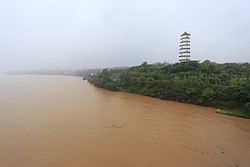geo.wikisort.org - River
The Gan River (simplified Chinese: 赣江; traditional Chinese: 贛江; pinyin: Gàn Jiāng, Gan: Kōm-kong) runs north through the western part of Jiangxi before flowing into Lake Poyang and thus the Yangtze River. The Xiang-Gan uplands separate it from the Xiang River of neighboring eastern Hunan.[1]
| Gan River | |
|---|---|
 Gan River and Yuhong Pagoda in Ganzhou | |
 | |
| Native name | 赣江 (Chinese) |
| Location | |
| Country | People's Republic of China |
| Province | Jiangxi |
| Physical characteristics | |
| Mouth | |
• location | Lake Poyang |
| Length | 599 km (372 mi) |
| Basin size | 103,107 km2 (39,810 sq mi) |
| Discharge | |
| • average | 2,861 m3/s (101,000 cu ft/s) |
| Basin features | |
| Tributaries | |
| • left | Gong River, Zhang River |
| • right | Mei River |
Two similarly sized rivers, the Gong River which is the southern tributary and the Mei River from the north combine in Yudu County, Jiangxi, to form the Gan. The Gan River flows 527 km (327 mi) before splitting into distributaries just north of Nanchang. The longest of these, the North Branch, is several times longer than the other distributaries at 72 km (45 mi). The Gan River is the major geographical feature of Jiangxi, and gives its name to the Gan variety of Chinese[2] as well as the province's one-character abbreviation.[3]
The river feeds into Lake Poyang, which in turns connects with the Yangtze.[4]
See also
- List of rivers in China
- 2010 South China floods
References
- Carol Benedict (2011). "Chinese Tobacco Production, 1600 to 1750". Golden-Silk Smoke: A History of Tobacco in China, 1550–2010. University of California Press. p. 41. ISBN 9780520948563.
- James Stuart Olson (1998). An Ethnohistorical Dictionary of China. Greenwood Press. p. 80. ISBN 9780313288531. Retrieved 2 March 2019.
- 高考地理:中国各省份简称历来 (in Simplified Chinese). Sohu Education. 2017-07-08. Archived from the original on 2018-12-18. Retrieved 2018-12-17.
19、江西--地处长江中下游南岸,赣江是省内最大的河流,故简称“赣”
- Stephen Turnbull (2002). "A Case Study of Chinese Fighting Ships". Fighting Ships of the Far East (1): China and Southeast Asia 202 BC-AD 1419. Osprey Publishing. p. 37. ISBN 9781782000174.
External links
- . Collier's New Encyclopedia. 1921.
На других языках
[de] Gan Jiang
Der Gan Jiang („Gan-Fluss“; chinesisch .mw-parser-output .Hani{font-size:110%}赣江, Pinyin Gàn Jiāng) ist der größte Fluss in der chinesischen Provinz Jiangxi.- [en] Gan River
[es] Río Gan
El río Gan (en chino, 赣江; pinyin, Gàn Jiāng, gan, Kōm-kong) es un río que discurre por la provincia de Jiangxi de la República Popular China. Se trata de un afluente del curso inferior del río Yangtsé. Tiene una longitud de 751 kilómetros (991 con las cabeceras) y drena una cuenca de unos 83 500 km², mayor que países como República Checa, Panamá o Serbia.[it] Gan (fiume)
Il Gan (cinese: 赣江; pinyin: Gan Jiang; romanizzazione Wade-Giles: Kan Chiang) è un fiume della Cina che scorre prevalentemente nello sheng (provincia) del Jiangxi. Il fiume Gan è uno dei principali affluenti meridionali del fiume Yangtze (Chang Jiang). I suoi rami sorgentizi hanno origine nella provincia del Guangdong, dove i monti Dayu dividono il Jiangxi sud-occidentale dal Guangdong. Questo torrente superiore è chiamato fiume Zhang. Un altro torrente, il fiume Gong, nasce sui monti Jiulian nell'estremità meridionale del Jiangxi. Questi due torrenti si riuniscono nei pressi della città di Ganzhou, e da qui il Gan scorre verso nord attraverso la provincia del Jiangxi fino al lago Poyang e, da qui, allo Yangtze. In epoca storica la valle del fiume costituì un'importante via che collegava Guangzhou (Canton) nel Guangdong alla valle dello Yangtze a nord. La lunghezza totale del Gan è di 815 km.[ru] Ганьцзян
Ганьцзян[1][2] (кит. 赣江, пиньинь Gàn jiāng) — река в Китае, самая длинная река в провинции Цзянси, впадает в озеро Поянху[2], стекающее в Янцзы. Главная транспортная артерия городского округа Наньчан.Другой контент может иметь иную лицензию. Перед использованием материалов сайта WikiSort.org внимательно изучите правила лицензирования конкретных элементов наполнения сайта.
WikiSort.org - проект по пересортировке и дополнению контента Википедии